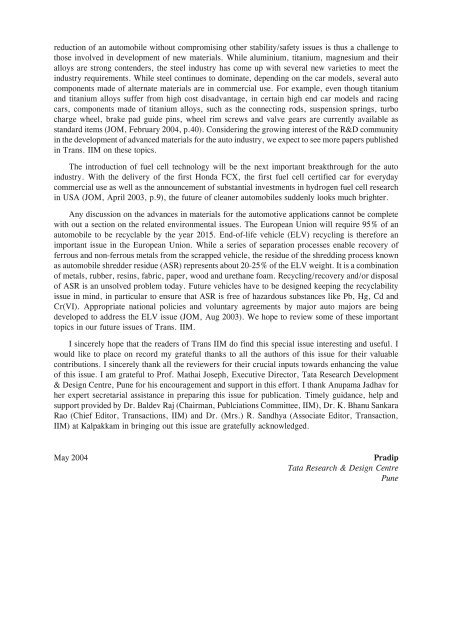PREFACE Indian auto industry has come of age. Passenger vehicle ...
PREFACE Indian auto industry has come of age. Passenger vehicle ...
PREFACE Indian auto industry has come of age. Passenger vehicle ...
Create successful ePaper yourself
Turn your PDF publications into a flip-book with our unique Google optimized e-Paper software.
eduction <strong>of</strong> an <strong>auto</strong>mobile without compromising other stability/safety issues is thus a challenge to<br />
those involved in development <strong>of</strong> new materials. While aluminium, titanium, magnesium and their<br />
alloys are strong contenders, the steel <strong>industry</strong> <strong>has</strong> <strong>come</strong> up with several new varieties to meet the<br />
<strong>industry</strong> requirements. While steel continues to dominate, depending on the car models, several <strong>auto</strong><br />
components made <strong>of</strong> alternate materials are in commercial use. For example, even though titanium<br />
and titanium alloys suffer from high cost disadvant<strong>age</strong>, in certain high end car models and racing<br />
cars, components made <strong>of</strong> titanium alloys, such as the connecting rods, suspension springs, turbo<br />
charge wheel, brake pad guide pins, wheel rim screws and valve gears are currently available as<br />
standard items (JOM, February 2004, p.40). Considering the growing interest <strong>of</strong> the R&D community<br />
in the development <strong>of</strong> advanced materials for the <strong>auto</strong> <strong>industry</strong>, we expect to see more papers published<br />
in Trans. IIM on these topics.<br />
The introduction <strong>of</strong> fuel cell technology will be the next important breakthrough for the <strong>auto</strong><br />
<strong>industry</strong>. With the delivery <strong>of</strong> the first Honda FCX, the first fuel cell certified car for everyday<br />
commercial use as well as the announcement <strong>of</strong> substantial investments in hydrogen fuel cell research<br />
in USA (JOM, April 2003, p.9), the future <strong>of</strong> cleaner <strong>auto</strong>mobiles suddenly looks much brighter.<br />
Any discussion on the advances in materials for the <strong>auto</strong>motive applications cannot be complete<br />
with out a section on the related environmental issues. The European Union will require 95% <strong>of</strong> an<br />
<strong>auto</strong>mobile to be recyclable by the year 2015. End-<strong>of</strong>-life <strong>vehicle</strong> (ELV) recycling is therefore an<br />
important issue in the European Union. While a series <strong>of</strong> separation processes enable recovery <strong>of</strong><br />
ferrous and non-ferrous metals from the scrapped <strong>vehicle</strong>, the residue <strong>of</strong> the shredding process known<br />
as <strong>auto</strong>mobile shredder residue (ASR) represents about 20-25% <strong>of</strong> the ELV weight. It is a combination<br />
<strong>of</strong> metals, rubber, resins, fabric, paper, wood and urethane foam. Recycling/recovery and/or disposal<br />
<strong>of</strong> ASR is an unsolved problem today. Future <strong>vehicle</strong>s have to be designed keeping the recyclability<br />
issue in mind, in particular to ensure that ASR is free <strong>of</strong> hazardous substances like Pb, Hg, Cd and<br />
Cr(VI). Appropriate national policies and voluntary agreements by major <strong>auto</strong> majors are being<br />
developed to address the ELV issue (JOM, Aug 2003). We hope to review some <strong>of</strong> these important<br />
topics in our future issues <strong>of</strong> Trans. IIM.<br />
I sincerely hope that the readers <strong>of</strong> Trans IIM do find this special issue interesting and useful. I<br />
would like to place on record my grateful thanks to all the authors <strong>of</strong> this issue for their valuable<br />
contributions. I sincerely thank all the reviewers for their crucial inputs towards enhancing the value<br />
<strong>of</strong> this issue. I am grateful to Pr<strong>of</strong>. Mathai Joseph, Executive Director, Tata Research Development<br />
& Design Centre, Pune for his encour<strong>age</strong>ment and support in this effort. I thank Anupama Jadhav for<br />
her expert secretarial assistance in preparing this issue for publication. Timely guidance, help and<br />
support provided by Dr. Baldev Raj (Chairman, Publciations Committee, IIM), Dr. K. Bhanu Sankara<br />
Rao (Chief Editor, Transactions, IIM) and Dr. (Mrs.) R. Sandhya (Associate Editor, Transaction,<br />
IIM) at Kalpakkam in bringing out this issue are gratefully acknowledged.<br />
May 2004<br />
Pradip<br />
Tata Research & Design Centre<br />
Pune
















